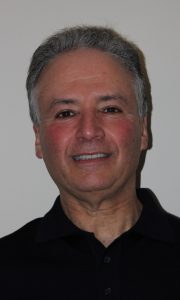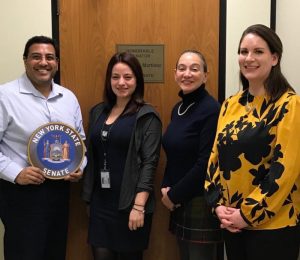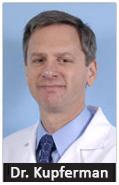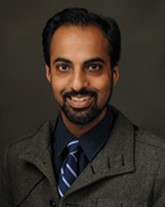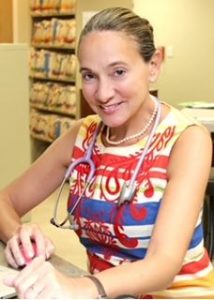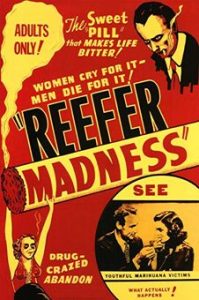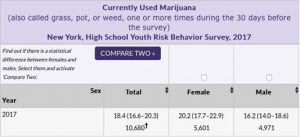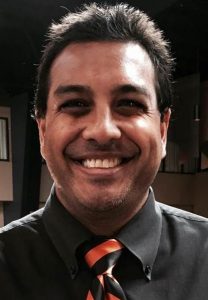Dear NYS AAP – Chapter 2 Member,
As a Chapter, and in cooperation with Chapters 1 and 3 as the NYS AAP (District II), we have been involved in governmental affairs and initiatives in New York City, Long Island, Albany, and in Washington that will benefit the children we serve and society as a whole. We are proud to share these efforts, and other important information with you. Please see below for details.
Steven J. Goldstein, MD, FAAP
President, NYS AAP – Chapter 2
SJG34@Cornell.edu
DON’T MISS THE NYS AAP’S ANNUAL ADVOCACY DAY!
REGISTER ONLINE here!
|
WHEN:
|
Tuesday, March 19, 20198:00am Breakfast 9:00am Morning Session Begins 12:00pm Lunch, followed by Scheduled Visits with Legislators 3:30pm Adjourn |
|
WHERE:
|
University Club 151 Washington Ave. Albany, NY 12210 |
| WHO: | This event is for members of the NYS AAP – Chapters 1, 2 & 3. There is no charge to attend. |
|
WHY:
|
Come to the State Capitol and Advocate for Kids and Pediatricians! Meet Key Legislators and State Agency Decision Makers. Meet with Your Assemblymember & Your Senator to educate them about the important issues in children’s health and well being. |
Advocacy for Gun Violence Prevention
On February 25th in New York City, Governor Andrew Cuomo, with House Speaker Nancy Pelosi at his side, signed landmark legislation known as the “Red Flag Bill” creating a mechanism for ERPO, Extreme Risk Protection Orders in New York State. This bill allows teachers and administrators to request that guns belonging to individuals seen as unstable or as a threat be confiscated pending a hearing in order to protect students and society. The Chapter has been advocating for ERPO legislation for years. Members of Chapters 2 and 3 were in attendance at this historic signing.
On March 4th we received word that the NY State Senate and Assembly passed Gun Safe Storage legislation. Elie Ward, our Director of Policy, Advocacy & External Relations, played a role in crafting this landmark achievement, which was bolstered by the unceasing advocacy efforts of Chapter members.
But there is more to be done! Our advocacy on Funding for Research about gun violence prevention at the state and federal levels is ongoing. We need your voice!
Chapters 2 and 3 recently joined with Chapter 1 to create a statewide committee to address gun violence prevention in New York. If you would like to get involved, please email our Executive Directors: Chapters 2 & 3, Jessica Geslani at jgeslani@aap.org, and Chapter 1, Chris Bell at cbell@mcms.org.
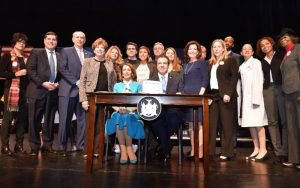
Chapter 2 Legislative Committee Member Dr. Eve Krief is in the white coat and to the right of Governor Cuomo
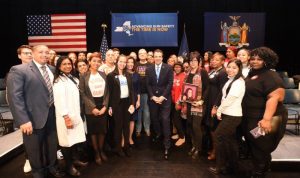
Chapter 3 Member and Co-Chair of the joint Chapters Gun Violence Prevention Committee, Dr. Nina Agrawal, is in the white coat to the left of the Governor, pictured with members of New Yorkers Against Gun Violence.
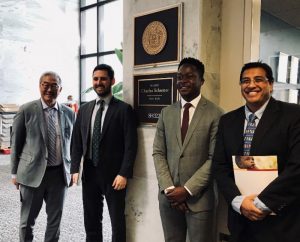
National AAP President Dr. Kyle Yasuda (left) and Chapter 2 VP Dr. Shetal Shah (right) flanking Senator Charles Schumer’s Legislative Aides at appointment in February advocating for gun violence prevention legislation.
Vaccine Exemptions
Sometimes the work that you don’t see is important. Vice President Shetal Shah and Legislative Committee Member Eve Krief visited NY State Senator Monica Martinez to discuss her bill to streamline applications for vaccine exemptions. Subsequently, she agreed to rewrite the bill and have us review it. The Chapters and National AAP believe that the only vaccine exemption should be for legitimate medical reasons.
Updates on Immigration Issues
- Decision Reversed to Move an ICE Facility to the Nassau University Medical Center – Nassau County Executive Laura Curran reversed her decision to move an ICE facility to the Nassau University Medical Center, a move that could inhibit families from seeking healthcare for their children. The Chapter sent a strongly worded protest within 24 hours of her initial decision, contributing to her reversal.
- Congressman Jerry Nadler Opens Hearings on Family Separation – “In our first immigration-related hearing this Congress, the Judiciary Committee will finally hold this Administration accountable for its indefensible and repugnant family separation policy, and for the injuries it has inflicted on thousands of children and families.”
Congressman Nadler’s remarks linked here are worth reading. He refers to the AAP’s work on family separation. - Kids on the Line – An ongoing investigation into family separation and the treatment of migrant children.
Chapter 2 Membership Committee – Call for Members!
As Membership Committee Chair, I would like to invite you to join the Committee to brainstorm about new ideas to increase our membership and improve the experience of our current members. Plans for a first dinner meeting at a restaurant are underway.
I am a strong believer in teamwork and look forward to collaborating with you and hearing your ideas! Please join me!
My best regards,
Juan C. Kupferman
JKupferman@maimonidesmed.org
RECORDED WEBINAR – “Don’t Be Lost in Transition:
Prepare & Efficiently Transfer Youth With and Without Special Health Care Needs to Adult Medical Care”
Many pediatricians feel unprepared to help their patients transition to adult medical care. Click this link to watch an excellent introduction to the issue with valuable resources from Drs. Sophia Jan of Chapter 2 and Lynn Davidson of Chapter 3. The webinar took place on February 28th and is worthy of your attention.
Annual Leadership Forum
The AAP Annual Leadership Forum, where resolutions and policy suggestions from AAP members are discussed and voted on, takes place in mid-March at AAP headquarters in Itasca, Illinois. Chapter 2 has a number of resolutions that will be considered and has been nominated for the Outstanding Chapter Award in the Large Chapter category. We’ll keep you posted as the ALF progresses.
Here is a link to the entire roster of ALF Resolutions.
Chapter 2 initiated resolutions may be found here and are listed below:
- “Public Education About Intramuscular Vitamin K Administration at Birth” by Shetal Shah
- “Revising the AAP Bright Futures Guidelines on Gun Safety Anticipatory Guidance” by Jennifer Grad, Dani Holmes and Christian Pulcini
- “Expansion of Options for Publications as Membership Benefits” by Jack Levine
- “Chapter Membership for Executive Committee Members of AAP National Sections, Councils, and Committees” by Steve Goldstein
New NYS School Health Examination Form Implementation Update
- New NYS School Health Examination Form Implementation Year Memo – The memo linked here communicated that the NYSED is working with medical providers through their professional organizations (such as the NYS AAP) to develop a format that can be utilized in electronic health record systems. Until further notice you should continue to accept any health exam form received. The NYSED will disseminate information in the coming months regarding changes to the form along with when it will be required. Stay tuned for updates!
CDC Request for Measles Outbreak Support
From January 1 to February 21, 2019, 159* people from 10 states (CA, CO, CT, GA, IL, NJ, NY, OR, TX, and WA) have been reported as having measles. Five outbreaks (defined as 3 or more linked cases) have been reported, in Rockland County, New York; Monroe County, New York; New York City; Washington; Texas; and Illinois. Of these outbreaks, 2 outbreaks are ongoing from 2018. CDC urges healthcare professionals to ensure that all patients are up to date on MMR vaccine, including before international travel.
What Should Clinicians Do?
- Discuss the importance of MMR vaccine with parents. Listen and respond to parents’ questions. When parents have questions, it does not necessarily mean they won’t accept vaccines. Sometimes, they simply want your answers to their questions.
- Ensure all patients are up to date on measles, mumps, rubella (MMR) vaccine: 1) – Children need 2 doses of MMR: one dose at 12-15 months and another dose at 4-6 years. 2). Before any international travel, infants 6-11 months need 1 dose of MMR vaccine, children 12 months and older need 2 doses separated by at least 28 days, and teenagers and adults who do not have evidence of immunity against measles need 2 doses separated by at least 28 days.
- Consider measles in patients presenting with febrile rash illness and clinically compatible measles symptoms (cough, coryza, and conjunctivitis), and ask patients about recent travel internationally or to domestic venues frequented by international travelers, as well as a history of measles exposures in their communities.
- Promptly isolate patients with suspected measles to avoid disease transmission and immediately report the suspect measles case to the health department.
- Obtain specimens for testing from patients with suspected measles, including viral specimens for genotyping, which can help determine the source of the virus. Contact the local health department with questions about submitting specimens for testing.
For more information, including guidelines for patient evaluation, diagnosis and management, visit: https://www.cdc.gov/measles/hcp/index.html
We’ll help you pursue your passion within Pediatrics! Send us an email describing your interest and we will connect you with the right people to get you involved. Please contact me or our Executive Director, Jessica Geslani, at jgeslani@aap.org
Follow Chapter 2 on Twitter: @NYSAAPCh2
My best,
Steve Goldstein, Chapter President SJG34@Cornell.edu | Twitter: @SteveGoldstei10
and the Officers:
Shetal Shah, Vice President shetaldoc@hotmail.com | Twitter @NICUBatman
Robert Lee, Secretary rlee@aap.net
Sanjivan Patel, Treasurer sapatel@wyckoffhospital.org

